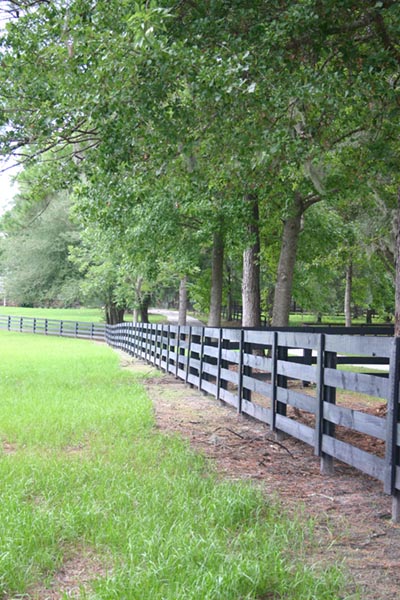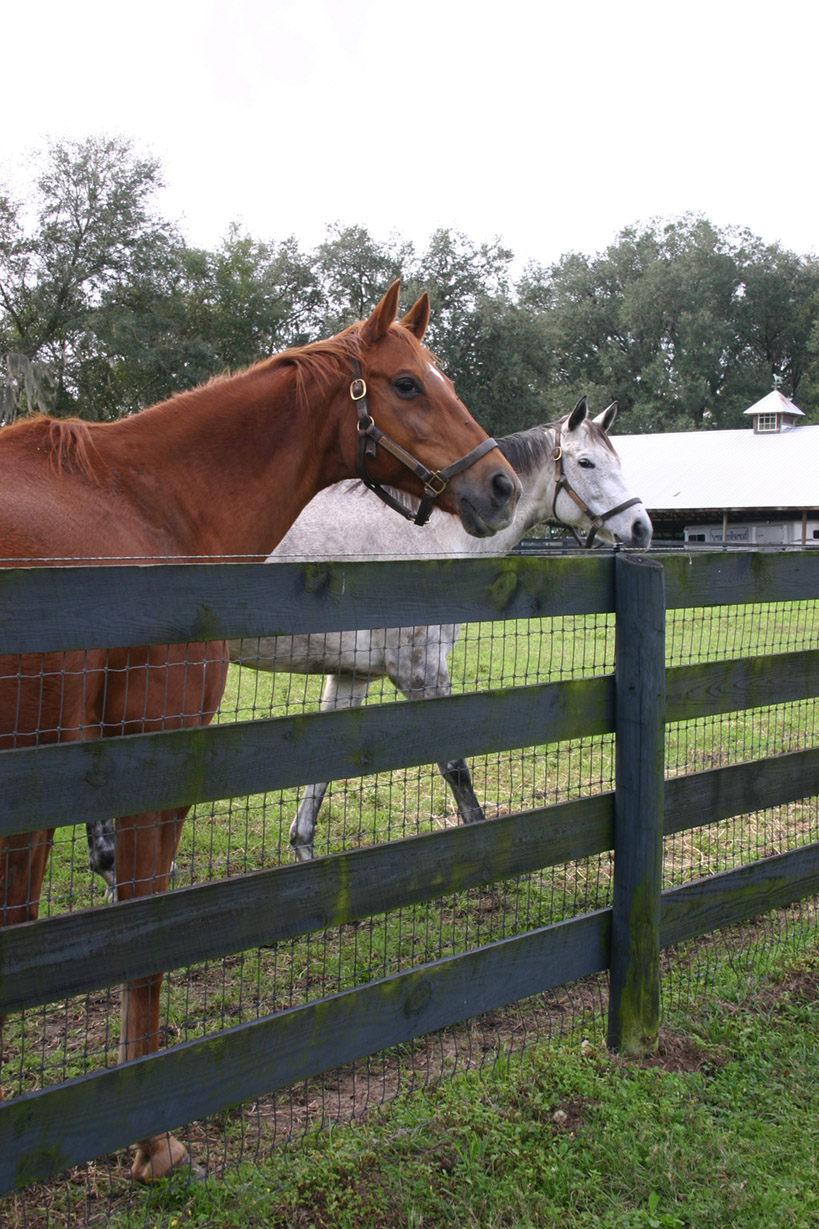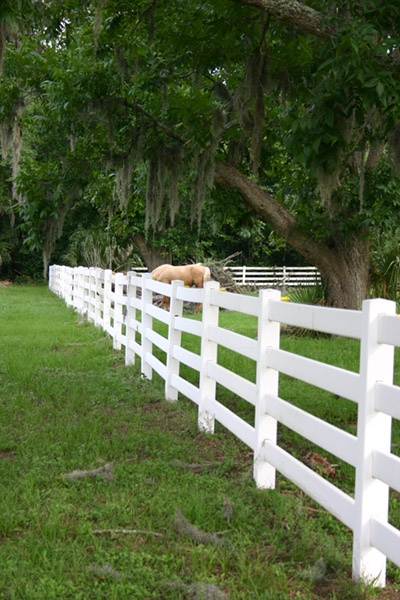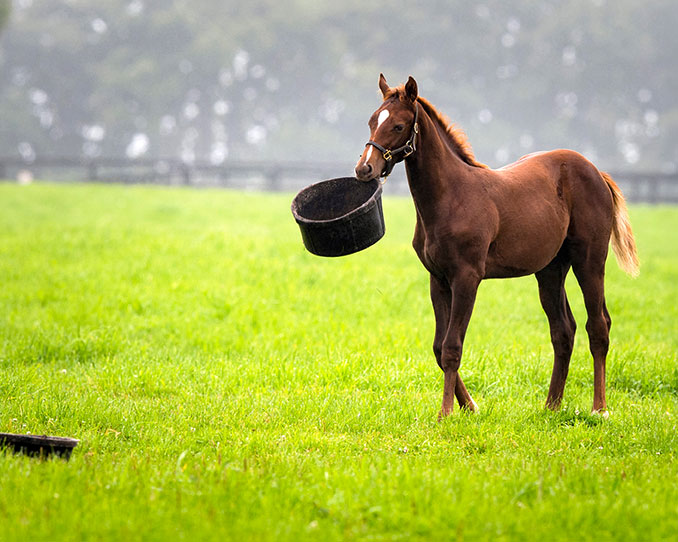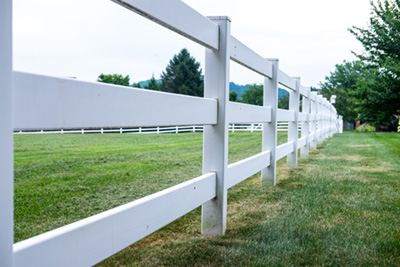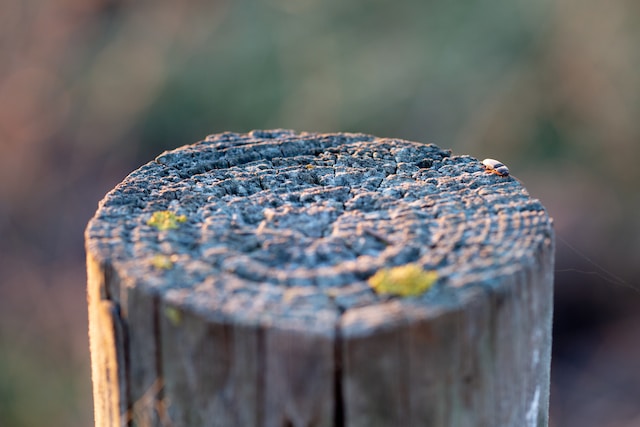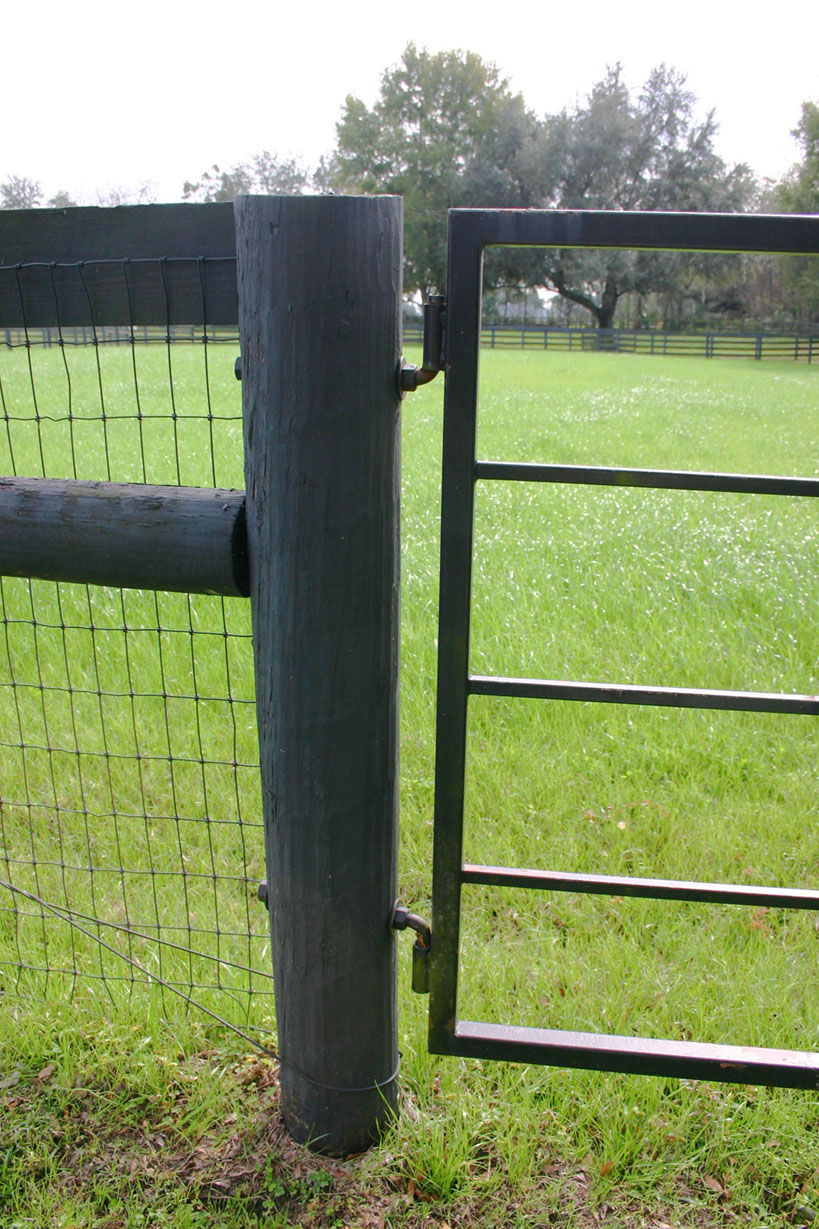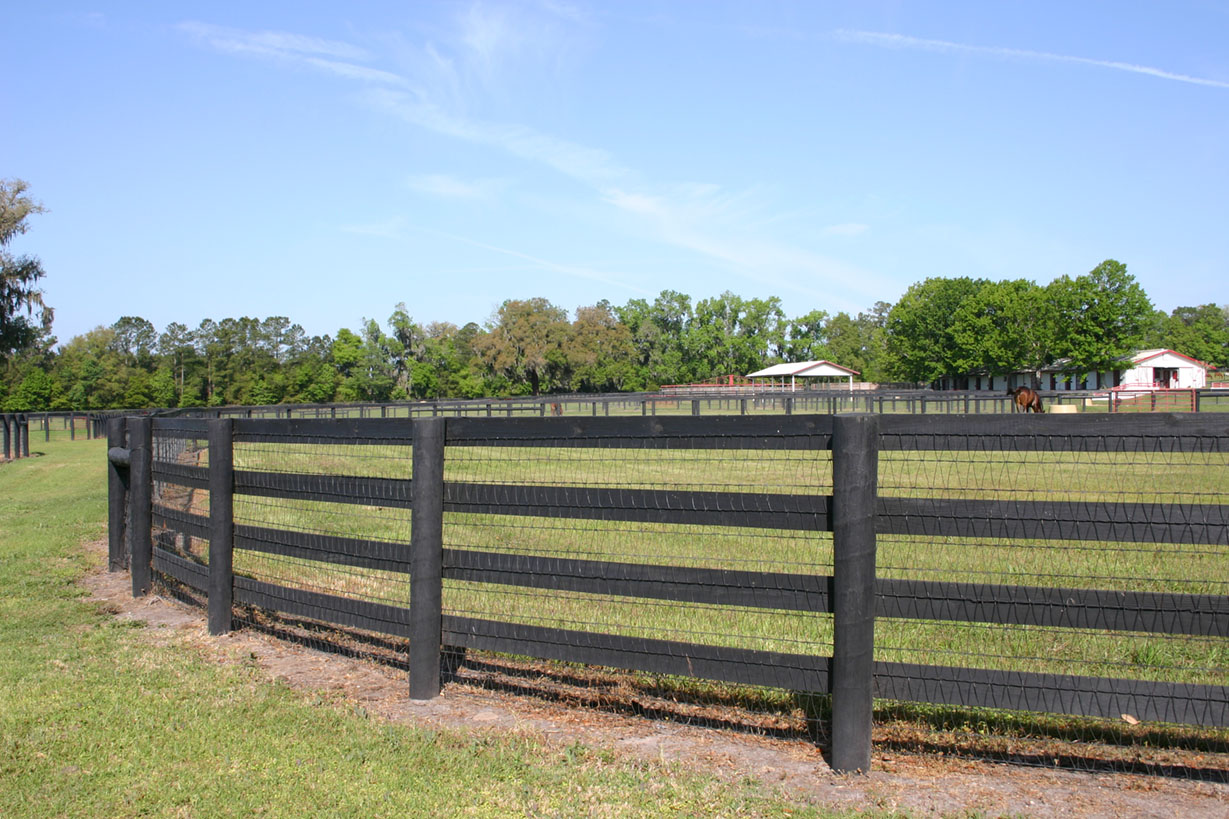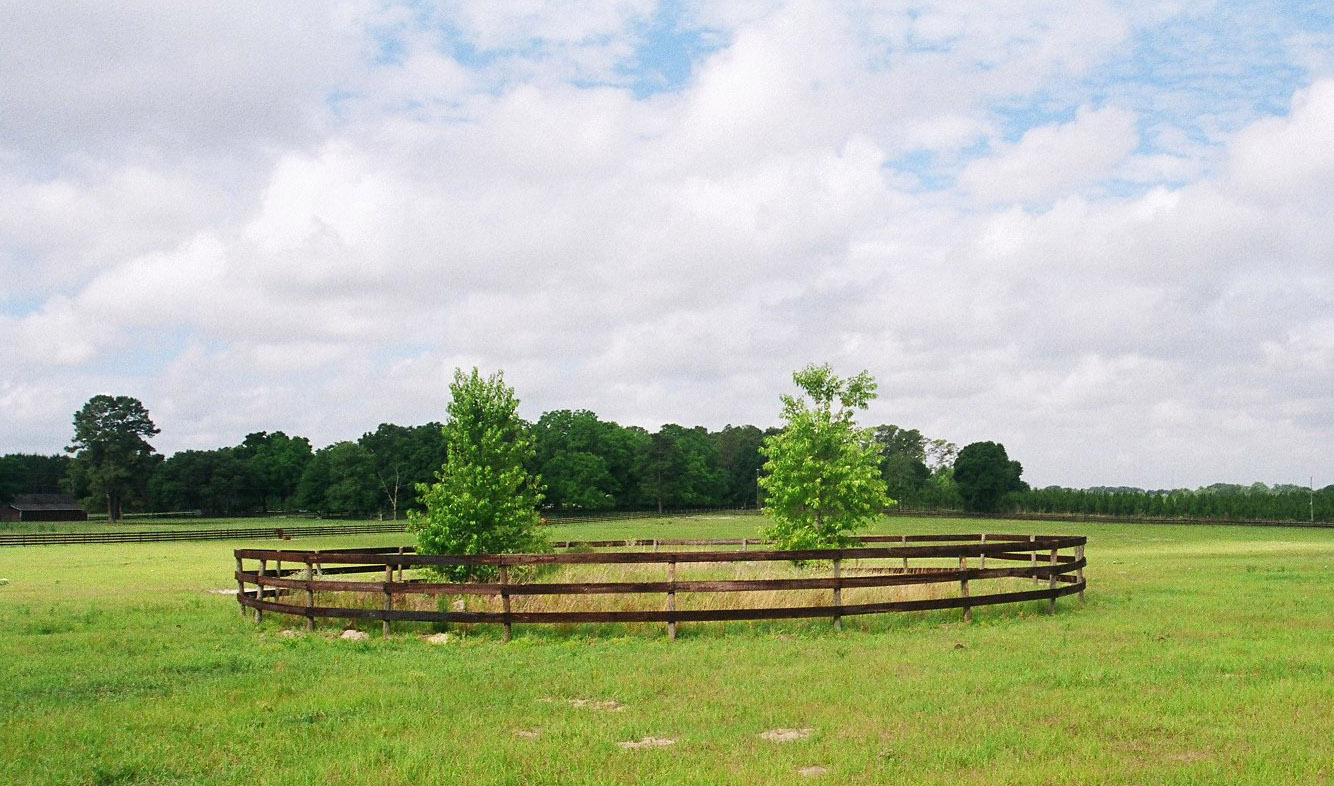
Welcome to Horse Capital of the World®:
Get Familiar with Equine Fencing in Central Florida
by
Cynthia McFarland
“Good fences make good neighbors.”
When Robert Frost penned those words in his poem, “Mending Wall,” he wasn’t talking about containing horses.
Of course, Frost became most revered for his poetry, not farming, but that line in his famous poem has become well known.
In addition to keeping peace with the neighbors, good fences keep horses safely enclosed and help prevent an array of problems.
The fences that were common in Frost’s part of New Hampshire are definitely not what one finds in the Ocala area. If you’ve moved to the Horse Capital of the World® from another part of the country, you’ll discover a variety of equine fencing styles here, but you’ll be hard pressed to find a stone wall in the mix.
To better explain the fencing options most common in this part of Central Florida, we reached out to Seminole Fence, which is owned by the husband-wife team of Kenny and Kelly Bruner.
Originally from Kentucky, the Bruners moved to Ocala specifically because fence can be built year-round here—unlike in many northern regions. They established Seminole Fence in 2007 and built it into a thriving company.
Photo courtesy of Cynthia MacFarland
Options abound
When it comes to horse fencing in our area, you’ll find multiple options, with the following found on many Ocala horse farms:
-
- Non-climb wire with top board
- Four board
- Three board
- Centaur® Fence Systems
- Four rail vinyl
Let’s take a closer look at each.
Non-climb wire with top board
Photo courtesy of Cynthia McFarland
This is the most popular option on many breeding farms due to the safety factor.
For pastures or paddocks used for mares and foals, diamond-V mesh wire with a top board has been a classic choice for years. However, because of the increased expense of diamond-V mesh, Kelly Bruner says more horse owners are going with 2×4-inch non-climb wire.
Both types of wire are considered “horse safe” and help keep predators out, while the small openings in the wire prevent horses from getting a leg caught.
“The 2×4-inch non-climb wire fence with a top board is the most popular fence here,” says Bruner. “The board keeps the top of the wire from bending and makes the fence more visible.”
The finished fence is typically 50 to 52 inches tall.
One type of wire fencing that is not recommended for horses is field fence. This wire has larger openings and is more suited for livestock such as cattle, sheep, and goats.
Bruner notes that some farms add non-climb wire to their three-board fences for added security, especially with perimeter fencing.
For best results whenever you’re putting up wire fencing, she recommends mowing the grass low along the fence line area before the installers come.
When wire fence is pulled tight and braced properly, it should stay tight for the lifetime of the posts. Over time, you may need to replace damaged top boards, which don’t last as long as the wire fencing.
Board fence
For the most traditional “horse farm” appearance, many farm owners opt for board fencing, using either three or four boards.
Most Thoroughbred farms in Ocala use either four-board wood fencing, non-climb wire with a top-board, or a combination of the two styles.
“We do more three-board fences than four-board, but only because of the cost of the additional board,” says Bruner.
“In Kentucky they use oak and popular, which are much harder than pine, but those hardwoods do not fully take pressure treatment. Here in Florida, pressure-treated pine is the number one choice for fence boards because it takes the treatment that defends against moisture and insects,” explains Bruner.
“Here we use pressure-treated pine or creosote boards, but creosote is much harder to obtain as there aren’t many treatment plants left in the U.S.,” she adds.
What exactly is “pressure-treated” lumber?
To preserve the wood, a process called “pressure treatment” introduces chemical preservatives into the lumber in an enclosed vat or cylinder. Vacuum and pressure literally force the chemicals into the wood, offering protection against decay and damage from insects, including termites.
Photo courtesy of Cynthia MacFarland
Because of the chemicals used in the process, treated lumber shouldn’t be used for projects where the wood will come in contact with human food, animal feed, or drinking water.
At lumberyards, treated wood is clearly identified by a plastic tag stapled to the end of the board or post.
Here in Ocala/Marion County, black board fences are standard and more common than white.
“White paint requires more upkeep and the paint itself costs a lot more,” says Bruner.
Painting a board fence will extend its lifetime, as well as enhance its appearance. A quality board fence can be expected to last 20 to 25 years if maintained properly, which means painting it roughly every four years.
“Painting a fence is just an extra protectant and will keep the outside of the boards looking better for a longer period of time,” says Bruner. “It’s like putting sunscreen on your skin.”
Posts are set on 8-foot centers and board spacing depends on whether three or four boards are used. The bottom board usually ranges from 8 to 14 inches off the ground, depending on how many boards being used.
Three- and four-board fences are typically 54 to 56 inches tall but can be customized to your desired height. When used for stallion paddocks, fences are at least 60 inches or taller, and five or more boards may be used.
For a stronger fence and for horse safety, it’s recommended that boards and wire be installed so that they face into the pasture, towards the horses. This puts the posts on the outside of the fence, which is safest for the horses.
For perimeter fencing along roads and driveways, some owners opt for face boards–short pieces of board nailed vertically over posts–to cover where the horizontal boards meet.
Bruner says this is for appearances, but also adds another layer of support.
Centaur® Fence Systems
Seminole Fence is a dealer for Centaur® horse fencing, which Bruner says is becoming more and more popular in the Ocala area.
Centaur® offers several different types of fencing, allowing horse owners to customize fencing design. Some options have the appearance of a traditional board fence, but without the maintenance of wood.
This patented fencing is designed with safety in mind and is known for its trademark flexibility, which allows horses to literally bounce off if they run into the fence.
Centaur® fencing is attached to standard treated wood posts.
“It’s maintenance free and posts don’t have to be 8-foot centers; they can be on 10 to 12-foot centers,” says Bruner.
“You don’t have to paint it and it can be electrified or not.”
Major advantages of this fencing are that it withstands temperature extremes, and won’t splinter, rust, rot or crack. It has a 20- to 30-year manufacturer warranty, is color-fast, stain- and mildew-resistant and never needs painting. The only upkeep is to tighten the fence as needed.
Bruner points out that in addition to being made in the U.S.A., Centaur® fencing is veterinarian approved.
Four-rail Vinyl
Four-rail vinyl (PVC) fencing has become popular on some farms as a replacement for traditional board fence. From a short distance, it looks very similar to white-painted board fencing.
This no-maintenance fencing never needs painting, and will not rot, rust, chip or peel. If the fence gets mildew spots over time, which it can when installed under trees, just pressure wash and it will look new again.
As with traditional board fencing, vinyl or PVC fencing can be installed with four boards or three and is typically installed at the same height as wood fencing.
Posts are also made of PVC. Generally, 5 by 5-inches square, they are installed on 8-foot centers.
Despite the no-maintenance benefits of this fencing, Bruner points out that there are some safety considerations to keep in mind. She says this is because on the odd occasion a horse runs into it and breaks a rail, the broken edges can be very sharp.
“We recommend it only for areas where horses won’t come in contact with it,” notes Bruner.
Posts
Wood posts are the foundation of a fence and are standard on all the above fencing options, except for four-rail vinyl.
Posts are sets on 8-foot centers and 4 to 5 inches is the minimum diameter recommended for horse enclosures. Larger posts are needed for corners, gates, and stud paddocks.
“Our soil here is a lot different from Kentucky, New York, Pennsylvania and other horse areas,” says Bruner. “People moving here often want to use concrete with posts, but we get so much rain, it can cause washouts along the fence lines and leave exposed concrete, so we don’t recommend it. Also, the rain will puddle around posts in set in concrete, which leads to rot, even though the posts are pressure treated.”
Because our area’s sandy soil doesn’t freeze, fence companies here typically use slightly shorter posts than companies do in northern regions where frozen ground pushes posts up out of the ground.
For routine pasture fencing, Seminole Fence uses 7-foot-long posts for line posts, but for brace posts and gate posts, they use 8-foot long posts that are bigger in diameter.
Treated posts should always be used, but Bruner notes that the part of the post in the ground won’t age as much as the exposed part of the post. This is why existing posts can often be reused when reconfiguring fence layout.
Thinking about gates
Photo courtesy of Cynthia MacFarland
This isn’t an area to cut costs.
Tubular galvanized or powder-coated steel gates, at least two inches thick, are recommended for horse enclosures. For added strength and security, gates are also available with wire mesh.
To accommodate tractors and equipment, 12-foot gates are standard for horse operations.
“Thers are many different gates and latching systems available, so think about it if you’re replacing gates or putting them in new,” says Bruner.
In addition to a gate’s materials, how it’s installed also determines how it opens and swings. If the gate won’t swing in both directions, make sure you consider which way you want it to open before the gate is hung.
“If you’re used to certain gates and move here, bring that to the attention of whoever’s installing your fence,” says Bruner.
Fencing redesign
What if you find the farm of your dreams, but aren’t totally thrilled with the layout of the paddocks and pastures? You love the farm, but wish the paddocks were bigger, or not so close to the house.
Bruner notes that fencing can often be adjusted to fit your specific needs. This doesn’t always mean tearing everything out and starting from scratch.
“Different disciplines have different fencing trends. Someone might have bought a farm set up for hunter-jumpers with very small paddocks. If you like a property but aren’t pleased with the layout of paddocks or pastures, it might not be a deal breaker. Sometimes you can reconfigure the fencing and reuse much of the material if it’s in good shape,” she explains.
Photo courtesy of Cynthia MacFarland
Seminole has torn out small paddocks and built new larger paddocks/pastures while reusing a large portion of the original fencing material.
“Very rarely do people buy a farm and not want to change something with the fencing,” says Bruner.
“Don’t be afraid of reconfiguring fencing. One of my favorite things to do is to help people see their property as a clean slate and reutilize much of the material already there. This saves cost and disposal fees, and it also saves trees.”
So long as the existing fencing is in good shape, boards, posts, wire and gates can often be reused.
Even when a new owner insists on taking down existing fences and having all new material installed, Bruner notes that there’s still a way to “recycle.”
“There are always people who want used material, so keep this in mind if you want all new fencing,” she says. “We have multiple equine rescue operations in Marion County. You can donate old fencing and gates you don’t want, and you’ll get a tax write off.”
Do your homework
Photo courtesy of Cynthia MacFarland
Bruner points out that many people who are relocating to Ocala/Marion County are buying raw land, which means all fencing is yet to be built.
Although this is an added expense, it also means you have the opportunity to have fencing done to your specifications from the start.
It might sound obvious, but knowing your property lines is a crucial starting point.
“Get a survey so you know your property lines,” says Bruner. “We recommend keeping fences a few inches inside your property lines. It’s not a law, but a recommendation.”
If your neighbors also have horses that are pastured close to your property line, you may want to set your fence back farther to maintain space between horse enclosures.
Keep in mind that it’s not legal to tie into your neighbor’s fence.
“Do your homework first. If you’re moving into an equestrian neighborhood or a deed-restricted equine community, you need to know the setbacks, fencing regulations and architectural requirements. It will save you headaches and remove any surprises,” advises Bruner.
When designing a farm from scratch, she always recommends landowners put in water lines before fencing is installed.
“Pre-planning makes everything go easier. Make your list and meet with everyone so you can coordinate. Think through what you’re wanting to achieve,” says Bruner.
For example, think ahead when laying out paddocks and pastures. While 8 feet between fence lines will keep horses from touching over the fences, this doesn’t allow much space for a vehicle in the lane. Twelve-foot lanes offer good spacing between fences.
Fence line maintenance
If you’re new to Central Florida, the growing season here can be an eye-opener.
No matter what type of fencing you’ve chosen, the fence line will need maintenance. This is true even if you’ve opted for a no-maintenance style of fence.
“Keep your fence lines clean and maintain them by trimming and spraying for weeds,” says Bruner. “Vegetation will ruin a fence. It will literally grow into a wire fence and encompass it.”
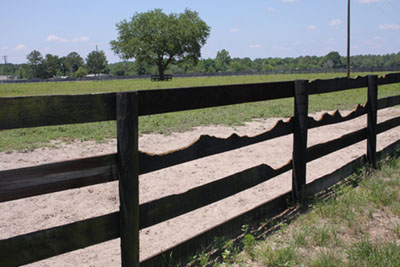
Photo courtesy of Cynthia MacFarland
Horse owners relocating to the Ocala area will find a tremendous variety in the equine properties listed with Showcase Properties of Central Florida, Inc., and that variety includes the fences on those farms.
Understanding the differences in Central Florida fence construction and design will make it easier to find the right farm that you and your horses can call home.
